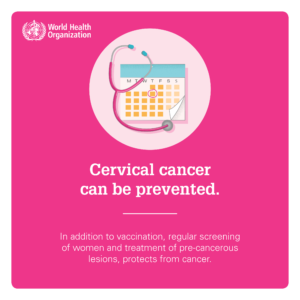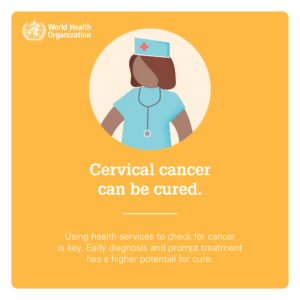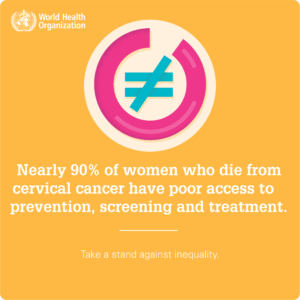Increased Risk and Poor Treatment of Cervical Cancer in Incarcerated Populations
Women involved in the criminal justice system are subjected to an increased risk of cervical cancer, with a risk four-five times greater than among the non-incarcerated population (2). There are many factors that result in this increased risk. Justice involved women are often exposed to elements such as human papillomavirus (HPV) or human immunodeficiency virus (HIV), early initiation of sexual acts, many sex partners, repeated pregnancies, smoking, low socioeconomic status and limited access to fruits and vegetables, all of which are correlate to an increased risk of cancer (3). Therefore, the conditions of life beyond incarceration for women tend to predispose the population to several conditions, subjecting them to poorer outcomes. Within institutions, the needs of women are ignored, and medical care is often withheld from an already vulnerable population. The flaws of the health care system in the United States disproportionally affects those with lower socioeconomic status, which is a large percentage of incarcerated members of society.
The low-quality care provided to those within the criminal justice system results in an increased risk to an already susceptible population. Across the country, women are not provided with the regular preventative testing recommended by oncologists and medical associations; the California Department of Corrections and Rehabilitation (CDCR) is just one example where preventative Pap-smear testing policies have not been implemented (3). Without authorized required  access to cervical cancer preventative testing, only a fraction of incarcerated women are offered the examination; however, those given the test frequently report mistreatment by their physicians. Participants in the Justice Now’s assessment project reflected on lack of privacy and sterility and reported that prison medical providers caused pain and bleeding during the procedure (3). The low-quality care, and mistreatment of patients, leads to distrust among women, and to their eventual refusal of upcoming medical treatment. This is especially prevalent among women with history of sexual or physical assault; the aggressive treatment causes discomfort and can be a reminder of painful memories (3). Because 75 percent or more of incarcerated women have experienced sexual or physical abuse, a large portion of incarcerated women fear treatment from their medical providers. Lack of quality care further decreases the percentage of women receiving vital preventative care.
access to cervical cancer preventative testing, only a fraction of incarcerated women are offered the examination; however, those given the test frequently report mistreatment by their physicians. Participants in the Justice Now’s assessment project reflected on lack of privacy and sterility and reported that prison medical providers caused pain and bleeding during the procedure (3). The low-quality care, and mistreatment of patients, leads to distrust among women, and to their eventual refusal of upcoming medical treatment. This is especially prevalent among women with history of sexual or physical assault; the aggressive treatment causes discomfort and can be a reminder of painful memories (3). Because 75 percent or more of incarcerated women have experienced sexual or physical abuse, a large portion of incarcerated women fear treatment from their medical providers. Lack of quality care further decreases the percentage of women receiving vital preventative care.
To make matters worse, the fraction of women offered the examination is further divided; less than half receive follow up appointments for abnormal results, which may include HIV testing, a colonoscopy or treatment of cervical cancer (2). By ignoring abnormal cells detected by the pap-smear, it completes negates the benefits of the diagnostic tool. Cervical cancer is extremely preventable and  treatable, thanks to modern medicine, but without immediate treatment, irreversible damage can be done to the body, including loss of reproductive ability. Women report being denied results and explanations
treatable, thanks to modern medicine, but without immediate treatment, irreversible damage can be done to the body, including loss of reproductive ability. Women report being denied results and explanations
regarding the procedure, erasing their access to health literacy (3). The lack of information and the denial of results decreases the likelihood that women will seek the examination and, ultimately, treatment of abnormal findings; therefore, incarcerated women are denied the ability to make decisions regarding their health (1). Without proper access to diagnostic tools and results, incarcerated women are denied the possibility of preventative action and treatment of cervical cancer.
Even upon release, women are less likely to seek out health care; 90 percent of people leave jail without health insurance. This is likely explained by the chaotic return to daily life; many women are forced to navigate housing, family, and income needs and attaining health care or insurance is no longer a priority (2). Housing is not guaranteed upon release, and parental or partner relationships may require attention. Because of history of incarceration, women are forced to take low paying jobs with limited benefits. In a society that regards health care as a commercial product, and without jobs that provide insurance, the costs of appointments and treatments become unmanageable and unrealistic; women often continue to lack access to preventative and medical care. Furthermore, a study reported that 40% of women returned to prison within a year of their release; with the imminent threat of incarceration, a woman is forced to avert her focus away from her health (2). These factors limit a woman’s ability to receive medical treatment and often have long-term effects. A woman may go her entire adult life without receiving correct treatment, which can result in a loss of reproductive capacity or other harm (3). Without detection, abnormal cervical cells result in cervical cancer, and without treatment, death.

As early as the 1960s, women within the criminal justice system have been known to have a higher rate of cervical cancer in comparison to non-incarcerated women; yet, improvements have not been made to erase this difference (Brousseau). Incarcerated populations have continued to suffer. It is clear that policies mandating preventative care for all women need to be implemented. The quality of care provided by medical professionals also needs to improve; rough providers should be terminated, and information should be readily available for all patients. Also, because of the preference for female medical employees, women should be assigned to certain vulnerable procedures (3). Ideally, improvements can be made to offer proper medical treatment to vulnerable populations and health care policy within the criminal justice system can be adjusted.
References:
- Brousseau, Erin Christine, et al. “Cervical Cancer Screening Access, Outcomes, and Prevalence of Dysplasia in Correctional Facilities: A Systematic Review.” Journal of Women’s Health, vol. 28, no. 12, Dec. 2019, pp. 1661–69. DOI.org (Crossref), doi:10.1089/jwh.2018.7440.
- Kelly, Patricia J., et al. “Challenges to Pap Smear Follow-up among Women in the Criminal Justice System.” Journal of Community Health, vol. 42, no. 1, Feb. 2017, pp. 15–20. DOI.org (Crossref), doi:10.1007/s10900-016-0225-3.
- Solinger, Rickie. Interrupted Life: Experiences of Incarcerated Women in the United States. University of California Press, 2010.